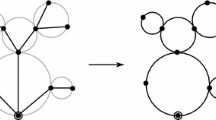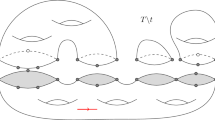Abstract
We introduce a growth process which samples sections of uniform infinite causal triangulations by elementary moves in which a single triangle is added. A relation to a random walk on the integer half line is shown. This relation is used to estimate the geodesic distance of a given triangle to the rooted boundary in terms of the time of the growth process and to determine from this the fractal dimension. Furthermore, convergence of the boundary process to a diffusion process is shown leading to an interesting duality relation between the growth process and a corresponding branching process.






Similar content being viewed by others
Notes
Lately also much progress has been made in understanding the scaling limit of DT as the Brownian map (see [5] for an overview).
References
Ambjørn, J., Durhuus, B., Jonsson, T.: Quantum Geometry. A Statistical Field Theory Approach. In: Cambridge Monogr. Math. Physics, vol. 1. Cambridge University Press, Cambridge, UK (1997)
Ambjørn, J., Loll, R.: Non-perturbative Lorentzian quantum gravity, causality and topology change. Nucl. Phys. B 536, 407–434 (1998). hep-th/9805108
Ambjørn, J., Loll, R., Watabiki, Y., Westra, W., Zohren, S.: New aspects of two-dimensional quantum gravity. Acta Phys. Pol. B 40, 3479–3507 (2009). arXiv:0911.4208
Angel, O., Schramm, O.: Uniform infinite planar triangulations. Commun. Math. Phys. 241, 191–213 (2003). math/0207153
Le Gall, J.F., Miermont, G.: Scaling limits of random trees and planar maps. In: Clay Mathematics Summer School 2010. arXiv:1101.4856 (2011)
Durhuus, B., Jonsson, T., Wheater, J.F.: On the spectral dimension of causal triangulations. J. Stat. Phys. 139, 859–881 (2010). arXiv:0908.3643
Sisko, V., Yambartsev, A., Zohren, S.: A note on weak convergence results for uniform infinite causal triangulations. Markov Process. Relat. Fields (2012, to appear). arXiv:1201.0264
Malyshev, V., Yambartsev, A., Zamyatin, A.: Two-dimensional Lorentzian models. Mosc. Math. J. 1(2), 1–18 (2001)
Di Francesco, P., Guitter, E., Kristjansen, C.: Integrable 2D Lorentzian gravity and random walks. Nucl. Phys. B 567, 515–553 (2000). hep-th/9907084
Krikun, M., Yambartsev, A.: Phase transition for the Ising model on the critical Lorentzian triangulation. arXiv:0810.2182
Angel, O.: Growth and percolation on the uniform infinite planar triangulation. Geom. Funct. Anal. 13, 935–974 (2003). math/0208123
Watabiki, Y.: Construction of noncritical string field theory by transfer matrix formalism in dynamical triangulation. Nucl. Phys. B 441, 119–166 (1995). hep-th/9401096
Ambjørn, J., Loll, R., Watabiki, Y., Westra, W., Zohren, S.: A causal alternative for c=0 strings. Acta Phys. Pol. B 39, 3355 (2008). arXiv:0810.2503
Ambjørn, J., Loll, R., Watabiki, Y., Westra, W., Zohren, S.: A new continuum limit of matrix models. Phys. Lett. B 670, 224–230 (2008). arXiv:0810.2408
Ambjørn, J., Loll, R., Watabiki, Y., Westra, W., Zohren, S.: A matrix model for 2D quantum gravity defined by causal dynamical triangulations. Phys. Lett. B 665, 252–256 (2008). arXiv:0804.0252
Durhuus, B., Jonsson, T., Wheater, J.F.: The spectral dimension of generic trees. J. Stat. Phys. 128, 1237–1260 (2006). math-ph/0607020
Aldous, D., Pitman, J.: Tree-valued Markov chains derived from Galton-Watson processes. Ann. Inst. Henri Poincaré Probab. Stat. 34(5), 637–686 (1998)
Zohren, S.: A causal perspective on random geometry. PhD thesis, Imperial College London (2008). arXiv:0905.0213
Ambjørn, J., Glaser, L., Görlich, A., Sato, Y.: New multicritical matrix models and multicritical 2d CDT. Phys. Lett. B 712, 109 (2012). arXiv:1202.4435
Gubser, S.S., Klebanov, I.R.: Scaling functions for baby universes in two-dimensional quantum gravity. Nucl. Phys. B 416, 827 (1994). hep-th/9310098
Atkin, M.R., Zohren, S.: An analytical analysis of CDT coupled to dimer-like matter. Phys. Lett. B 712, 445 (2012). arXiv:1202.4322
Durrett, R.: Probability: Theory and Examples, 2nd edn. Duxbury, Belmont (1996)
Durrett, R.: Stochastic Calculus: A Practical Introduction. CRC, Boca Raton (1996)
Billingsley, P.: Convergence of Probability Measures, 2nd edn. Wiley, New York (1999)
Ethier, S., Kurtz, T.: Markov Processes: Characterization and Convergence. Wiley, New York (1986)
Stroock, D.W., Varadhan, S.R.S.: Multidimensional Diffusion Processes. Springer, Berlin (1979)
Acknowledgements
The authors would like to thank Richard Gill for fruitful discussions. The work of V.S. was supported by FAPERJ (grants E-26/170.008/2008 and E-26/110.982/2008) and CNPq (grants 471891/2006-1, 309397/2008-1 and 471946/2008-7). The work of A.Y. was partly supported by CNPq 308510/2010-0. S.Z. would like to thank the Department of Statistics at São Paulo University (IME-USP) as well as the Institute for Pure and Applied Mathematics (IMPA) for kind hospitality. Financial support of FAPESP under project 2010/05891-2, as well as STFC and EPSRC is kindly acknowledged.
Author information
Authors and Affiliations
Corresponding author
Appendices
Appendix A: Proofs of Basic Lemmas
1.1 A.1 Proof of Lemma 3.2
Let \(\mathcal{F}_{n}=\sigma(M_{0},M_{1},\dots,M_{n})\). Recall that ξ n =M n+1−M n . We thus have \(M_{n} \in\mathcal{F}_{n}\) and \(\xi_{n} \in\mathcal{F}_{n+1}\). On {M n ≥1} one has
Note also that
Consider \(X_{n}=M_{n}^{2}-3n\). Let us prove that X n is a martingale adapted to \(\mathcal{F}_{n}\). Evidently \(X_{n} \in\mathcal{F}_{n}\) and \(\operatorname{E{}}|X_{n}|< \infty\). Therefore, we only need to check that \(\operatorname{E{}}(X_{n+1}|\mathcal{F}_{n})=X_{n}\). Using (A.1)–(A.2) we have

Thus one gets

and therefore,

With any sequence of positive numbers {a m } consider
Using the fact that X n is a martingale, it is easy to check that B n is also a martingale. One has

From (A.3), we get that if a m =mlogm, then there exists a constant C>0 such that \(\operatorname {E{}}B_{n}^{2}<C<\infty\). Therefore, using the L p convergence theorem (see e.g. Theorem 4.5 from Chap. 4 of [22]), one has that B n converges a.s. Using Kroneker’s Lemma (see e.g. Lemma 8.5 from Chap. 1 of [22]), we see that \(\frac{X_{n}}{n \log n}\to0\) a.s. and recalling the definition of X n , one gets Lemma 3.2.
1.2 A.2 Proof of Lemma 3.3
This proof proceeds using a similar strategy as the previous proof. Consider
From (A.1) it follows that X n is a martingale adapted to \(\mathcal{F}_{n}\). Using the fact that |ξ n |=1 and M n ≥1 for any n, we have
Consider further
Using the fact that X n is a martingale, one has again that B n is also a martingale and we have

Using (A.4), we get that if \(a_{m}=\sqrt{m}\log m\), then \(\sup_{n}\operatorname{E{}}B_{n}^{2}<\infty\). Using the L p convergence theorem, we observe that B n converges a.s. Finally, using Kroneker’s Lemma as before, we see that \(\frac{X_{n}}{\sqrt{n} \log n}\to0\) a.s. Recalling the definition of X n , we get Lemma 3.3.
Appendix B: Convergence of Markov Chains to Diffusion Processes
To prove Theorem 4.1 we need a little background on stochastic differential equations and convergence to diffusion. The following definition and theorem can for instance be found in [23] Chaps. 5 and 8, where the latter is a rather good introduction to the topic which itself is based on [24–26].
Definition B.1
We say that X t is a solution to the martingale problem for b and σ 2, or simply X solves MP(b,σ 2) if
are local martingales. Further, we say that the martingale problem is well-posed if there is uniqueness in distribution and no explosion.
Let us now consider a Markov chain \(Y^{(h)}_{mh}\), m≥0, taking values in a set \(\mathcal{X}_{h}\subset\mathbb{R}\) and having transition probabilities
Further, set \(X_{t}^{(h)}=Y^{(h)}_{h [t/h]}\) and define

with B(x,ϵ)={y:|y−x|<ϵ}.
The following theorem (see e.g. [23], Theorem 8.7.1) proves convergence of the Markov chain to a limiting diffusion:
Theorem B.1
Suppose that b and σ are continuous functions for which the martingale problem is well-posed and for R<∞ and ϵ>0
-
(1)
\(\lim_{h\to0}\sup_{|x|\leq R} |\sigma^{2}_{h}(x)-\sigma^{2}(x) |=0\)
-
(2)
lim h→0sup|x|≤R |b h (x)−b(x)|=0
-
(3)
\(\lim_{h\to0}\sup_{|x|\leq R} \Delta_{h}^{\epsilon}(x)=0\)
If \(X^{(h)}_{0}\to x\) then we have \(X^{(h)}_{t} \Rightarrow X_{t}\), in the sense of weak convergence on the functions space D[0,∞), where the continuous process X t is diffusive and solves the following Itô’s equation
The following is a well-known theorem from stochastic calculus (see e.g. [23], Theorem 5.6.1) regarding random time changes of a stochastic process:
Theorem B.2
Let X u be a solution of the martingale problem MP(b,σ 2) for u∈[0,∞), let g be a positive function and suppose that for all u∈[0,∞)
Define the inverse of τ u by \(\tau^{-1}_{s}=\inf\{ t: \tau_{t}>s\} \) and let \(Y_{s}=X_{\tau^{-1}_{s}}\), then Y s is a solution of MP(b/g,σ 2/g).
Rights and permissions
About this article
Cite this article
Sisko, V., Yambartsev, A. & Zohren, S. Growth of Uniform Infinite Causal Triangulations. J Stat Phys 150, 353–374 (2013). https://doi.org/10.1007/s10955-012-0665-9
Received:
Accepted:
Published:
Issue Date:
DOI: https://doi.org/10.1007/s10955-012-0665-9




